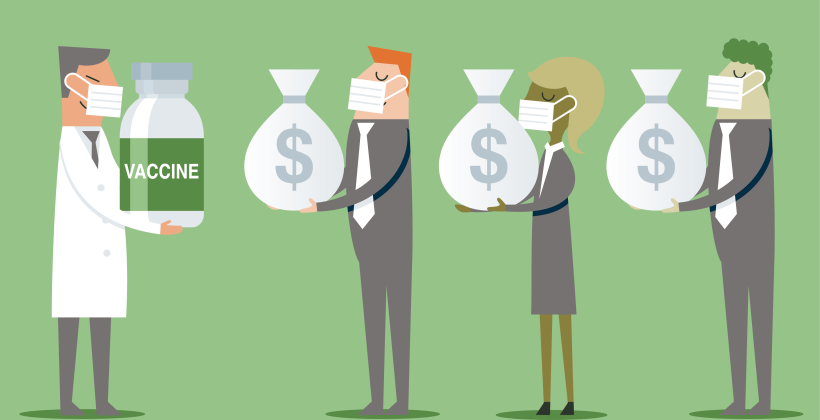
The race to produce a safe and effective COVID-19 vaccine candidate – in which over 200 labs are currently participating – has been accompanied by nationalist, action-oriented rhetoric by countries who have scrambled to establish bilateral deals with pharmaceuticals to secure a supply of doses. The sheer complexities and difficulty of bringing a new vaccine to market quickly and on such a vast global scale mean that production will be staggered. This means that when a vaccine candidate does cross the finish line (unlikely this side of 2021),1 global demand will far outstrip supply. The resulting price war among global competitors is likely to drive the cost of purchase up by 13 times2 more than under collective procurement. Without global coordination and intervention, the first vaccines will be sold to the wealthiest bidders, pushing lower-income countries to the back of the queue. Not only will the humanitarian, societal and economic costs be enormous, but COVID-19 will be able to continue its circulation within and beyond country borders. Global mechanisms have been launched to counter this scenario, but how can the unprecedented and universal need for vaccines be met fairly and effectively?
As a counterweight to this challenge, the COVAX Facility – a global collaboration between Gavi, the CEPI (Coalition for Epidemic Preparedness) and the World Health Organization – has an ambitious mandate to provide rapid and equitable global distribution of any new COVID-19 vaccines. COVAX has created a diverse portfolio of 10 COVID-19 vaccine candidates, with the aim of distributing two billion doses by the end of 2021. As the initial vaccine becomes available, doses will be made available to all participating countries – irrespective of demand or income status – to cover an initial 3% of their population, followed by an allocation of 20% for vulnerable populations.
High-income countries invest in COVAX to cover their own dose allocation, thereby financing the development and manufacturing of a diverse portfolio of vaccine candidates – an ‘insurance policy’ alongside their own bilateral deals. To date, 64 wealthier nations have committed financially. Lower-income countries can also sign up and are supported by ODA funding from higher-income countries, foundations, philanthropists and the private sector. Ninety-two lower-income countries are currently eligible for support.
This pooled demand helps to remove the risk of pre-product manufacturing expansion for pharmaceuticals and incentivises the scale-up of research and development. The architects of COVAX understand fair and equitable access to vaccines globally as the only way to mitigate the public health and economic impacts of COVID-19.3 Given its core focus on equity, COVAX provides a useful microcosm to explore the big questions we should be asking about fair and equitable access to vaccines.

Four big questions on equitable access to COVID-19 vaccines
As part of our ongoing thinking around current global challenges in the context of COVID-19, concerns around equity and vaccines continue to come up. The questions below group some of the most pressing areas concerning equity, which could guide future evaluation work on COVAX.
1. Is the vaccine allocation mechanism equitable?
In theory, distinguishing between equality and equity should be straightforward: while both principles promote fairness, equality achieves this by treating stakeholders identically regardless of need, while equity achieves this by treating stakeholders differently dependent on need. In practice, establishing whether COVAX is geared towards equity or equality is complex, given the multidimensional needs and inequalities that apply to vaccine access.
COVAX engages with equity primarily as an issue of inequalities in purchasing power across countries. This approach is therefore equitable in that it attempts to level the playing field on the demand side, so that inability to pay for vaccines does not impact access to initial doses. However, the extent to which the COVAX Advance Market Commitment has been successful at negotiating with high-income countries to secure funding and manage the impact of bilateral deals will have important implications for allocation. Our recent engagement with COVAX stakeholders revealed concerns that the allocation of vaccines through the facility could possibly be one of ‘leftovers’, due to the prioritisation by high-income countries of bilateral deals.
Furthermore, equity is sought by addressing differences in purchasing power but not the national-level threat or vulnerability — at least until initial doses have reached 20% of national populations.4 Since vaccines will initially be allocated as a fixed percentage of the population across all countries, irrespective of relative health system strength or epidemiological data, the initial distribution of COVAX vaccines could be seen as equal rather than equitable.
2. Who is involved in the process of defining equitable outcomes?
Equity is not just about the access that countries have to vaccines – it includes how different countries and stakeholders are or are not engaged with the process of defining equitable outcomes. Inevitably, in this crisis context, there is a need to act fast. Nevertheless, an equitable response will need to constantly balance the urgency of action with equitable engagement, starting from its inception stage.
In order to rapidly reach a politically workable system, ‘imperfect’ equity may be the best that can be achieved, and the issues raised above are perhaps inevitable given the complex negotiations that will have characterised the process of designing the allocation mechanism. This highlights the importance of equitable political engagement in these processes, particularly of low and middle-Income countries and civil society organisations.
Equitable outcomes are unlikely to be established behind closed doors and without a fair balance of stakeholders and range of perspectives at the decision-making table. Civil society groups have been expressing concern at their lack of participation and transparency in decision-making processes.5 Assessing breadth of participation and extent of transparency in decision-making processes will need to be a core area of enquiry of evaluating the equity of the response.
3. How will inequities at population-level be addressed?
COVAX has adopted WHO allocation guidelines6 for the distribution of vaccines across countries, which are aimed at covering health workers and the over-65 population, but ultimately each country has sovereignty over allocation criteria and delivery of vaccines. Many countries will face an uphill struggle in reaching these priority groups and are likely to need support to vaccinate other vulnerable groups – whether due to existing health conditions, lack of access to health facilities, poverty, and hard-to-reach locations.
Inequities are not only relevant to the supply of vaccines, but also to demand: as seen during the Ebola epidemic, in places where there is a lack of trust in state institutions, people may not demand services even when they are available. The provision of COVID-19 vaccines is not just a health intervention, but a social one and success will hinge on community buy-in. Future evaluative work will need to look at the extent to which programmes have invested sufficiently in supporting careful preparation, clear messaging and understanding of local contexts.
4. Will inequities be targeted through a health systems approach or through vertical interventions?
An HSS (health systems strengthening) approach7 could be the first step to address the inequities described under the previous question, but the extent to which this is being prioritised in the current response is yet to be seen. Inequities between national health systems mean that distributive outcomes within countries will greatly vary, even given an equal allocation of vaccines through COVAX.
Vertical interventions, with vaccines being ‘helicoptered in’ by humanitarian organisations and bypassing national health systems, may be effective at addressing inequities in the short term, for example targeting hard-to-reach populations. However, HSS approaches are needed to have a substantial and long-term impact on equity both within and across countries, by increasing national resilience to future health crises. Health system barriers to the effective provision of vaccines will need to be addressed, from protecting health workers to disease surveillance capacity.
Beyond the strict provision of vaccinations, the global response can be an opportunity to prepare for the next wave or another pandemic. Though structures to coordinate HSS exist within the overall COVID-19 testing, treatment and vaccines response8, the extent to which global initiatives are adequately addressing these challenges invites further questions.
What evidence do we need to help address inequality?
Global health players’ attempt to keep pace with the rapid and shifting dynamics accompanying COVID-19’s spread across the globe has led to mechanisms being developed and established quickly. The pandemic has called for unprecedented levels of global cooperation in a context laden with fear, uncertainty and complex political dynamics. Investments in global collaboration are critical, but there are still huge unknowns on how vaccine development will play out.
While we recognise this reality and the ambition and achievement to date of global initiatives such as COVAX, we should be wary of unintentionally undermining fairness and equity in vaccine access and distribution. The potential consequences could be tragic, both for the humanitarian, social and economic fortunes of countries and for our ability to control the overall outbreak. Carefully calibrating the mechanics of these ground-breaking global schemes to ensure equitable access and distribution across diverse geographies, political contexts and health system capacities is no easy task. Regard for the dimensions of equity underlying equitable vaccine distribution will be key. Real-time evaluative evidence can further inform and strengthen these collaborative efforts, help us navigate an evolving situation and prevent inequality from emerging as an unintended consequence. Global solutions not only require strong cooperation but focused efforts to level the playing field, as COVID-19 will only be brought under control when all countries – irrespective of wealth – can access safe and effective vaccines.
Author: Marco Maragno

